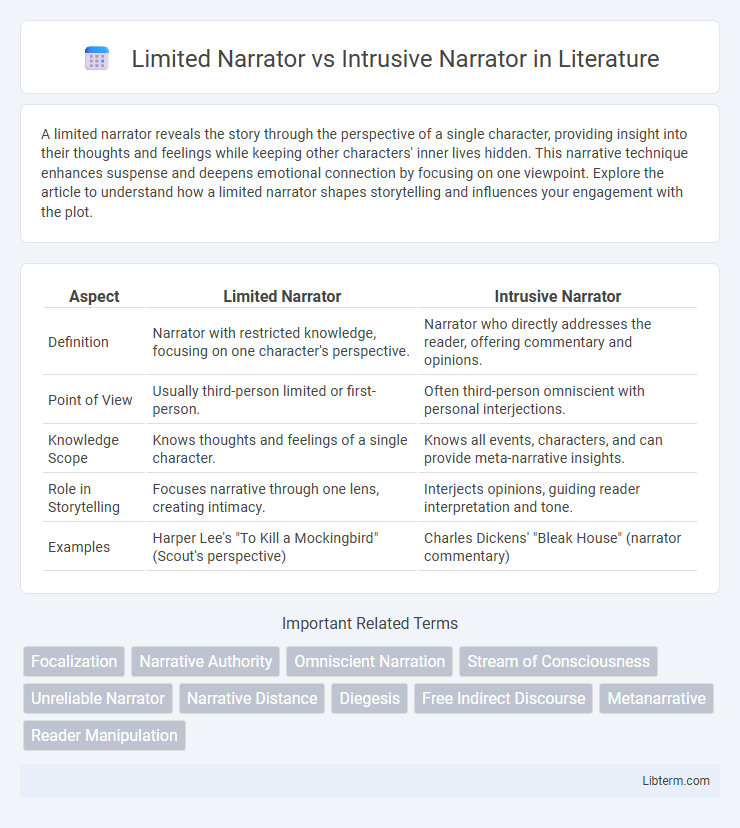A limited narrator reveals the story through the perspective of a single character, providing insight into their thoughts and feelings while keeping other characters' inner lives hidden. This narrative technique enhances suspense and deepens emotional connection by focusing on one viewpoint. Explore the article to understand how a limited narrator shapes storytelling and influences your engagement with the plot.
Table of Comparison
| Aspect | Limited Narrator | Intrusive Narrator |
|---|---|---|
| Definition | Narrator with restricted knowledge, focusing on one character's perspective. | Narrator who directly addresses the reader, offering commentary and opinions. |
| Point of View | Usually third-person limited or first-person. | Often third-person omniscient with personal interjections. |
| Knowledge Scope | Knows thoughts and feelings of a single character. | Knows all events, characters, and can provide meta-narrative insights. |
| Role in Storytelling | Focuses narrative through one lens, creating intimacy. | Interjects opinions, guiding reader interpretation and tone. |
| Examples | Harper Lee's "To Kill a Mockingbird" (Scout's perspective) | Charles Dickens' "Bleak House" (narrator commentary) |
Understanding Narration: An Overview
Limited narrators reveal the story through a single character's perspective, restricting knowledge to their thoughts and experiences, which creates intimacy and suspense. Intrusive narrators break the fourth wall by directly addressing the reader, offering commentary or insights beyond the story's events. Understanding these narration types enhances analysis of narrative reliability and authorial presence in storytelling.
Defining the Limited Narrator
The Limited Narrator provides a perspective confined to the thoughts, feelings, and knowledge of a single character, offering a focused, subjective view of the narrative. This type of narration restricts information to what the chosen character experiences and perceives, enhancing intimacy and immediacy. Contrasting this, an Intrusive Narrator breaks the fourth wall, offering commentary, opinions, or insights beyond the story's inner world, guiding the reader's interpretation.
What is an Intrusive Narrator?
An intrusive narrator directly addresses the reader, breaking the fourth wall to provide commentary, opinions, or background information beyond the story's immediate events. This narrative style often offers insight into the author's perspective, creating a meta-narrative layer that influences how the story is interpreted. Unlike limited narrators, who restrict the viewpoint to a character's thoughts and experiences, intrusive narrators actively engage with the audience and shape the narrative through their interjections.
Key Differences Between Limited and Intrusive Narration
Limited narration restricts the storytelling to the thoughts, feelings, and knowledge of a single character, creating a focused and subjective perspective. Intrusive narration involves the narrator stepping outside the story to directly address the reader, providing commentary, background information, or philosophical insights that influence interpretation. The key difference lies in the narrator's presence and control: limited narrators remain embedded within the narrative world, while intrusive narrators assert authorial voice and guide reader understanding from an external standpoint.
Effects on Reader Engagement
A Limited Narrator restricts the reader's perspective to the thoughts and experiences of a single character, fostering deep emotional connection and empathy by creating intimacy and suspense. An Intrusive Narrator, by contrast, breaks the fourth wall with commentary and direct address, shaping reader awareness and guiding interpretation but potentially reducing immersion. These narrative techniques manipulate engagement by either promoting personal identification or encouraging critical reflection on the story's themes.
Techniques Used by Limited Narrators
Limited narrators utilize techniques such as selective omniscience, presenting the story through a constrained viewpoint restricted to one character's thoughts and experiences. This approach employs focalization, emphasizing internal monologues and sensory details to create an intimate connection with the protagonist while maintaining narrative ambiguity. Through strategic withholding of information, limited narrators engage readers by revealing plot developments only as the focal character discovers them.
Techniques Used by Intrusive Narrators
Intrusive narrators employ direct commentary, breaking the fourth wall to address readers and provide explicit opinions or background information that shapes interpretation. They utilize self-reflexive language and editorializing techniques to guide audience perception and emphasize thematic elements. These narrators often disrupt narrative flow intentionally, emphasizing their presence and control over the storytelling.
Pros and Cons of Limited Narration
Limited narration offers a focused perspective that enhances character depth and allows readers to closely identify with the protagonist's experiences and emotions. However, it restricts the scope of the story by limiting information to what the narrator knows, which can lead to potential biases and incomplete understanding of the plot or other characters. This narrative style promotes mystery and suspense but may frustrate readers seeking a broader view or comprehensive background.
Pros and Cons of Intrusive Narration
Intrusive narration offers the advantage of directly engaging readers with the narrator's voice, providing insights, commentary, and context that can deepen understanding and add layers of meaning. This technique can enhance storytelling by creating a conversational tone and breaking the fourth wall, but it risks disrupting narrative immersion and can detract from character-driven perspectives. While intrusive narrators offer valuable exposition and thematic emphasis, they may alienate readers who prefer a more subtle, character-focused narrative approach typical of limited narration.
Choosing the Right Narrator for Your Story
Choosing between a limited narrator and an intrusive narrator depends on the desired narrative perspective and reader engagement. A limited narrator offers a focused, subjective viewpoint, revealing inner thoughts and emotions of a single character, which enhances intimacy and suspense. In contrast, an intrusive narrator breaks the fourth wall with direct commentary and opinions, guiding readers but potentially disrupting narrative immersion.
Limited Narrator Infographic

 libterm.com
libterm.com